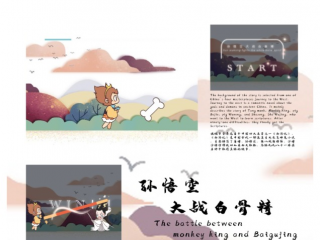April/May 2020 - GDUT Creative Computing

Sean Clark and Yi Ji have been running Creative Computing courses twice a year at Guangdong University of Technology in China since 2016. These courses typically introduce basic computer programming and hardware to students in the School of Art and Design. Topics taught in the past include Scratch programming, Arduino, BBC Micro:bit, A-Frame WebVR, and Processing programming.
Due to the COVID-19 pandemic. the big challenge for this course was to produce a curriculum that could be taught entirely online to a cohort of students who were still working from home. This meant that hardware-based tasks would not be possible, all teaching would be via video link and group working would also have to be managed online.
We decided to base the course around three Scratch-based tasks: 1) Develop an Initial Scratch Game; 2) Produce Computer Drawings, and; 3) Develop an Educational Game based around Cantonese Porcelain. For each task, students were expected to go through a Research-Design-Develop-Present cycle. We introduced them to Scratch and the topic of the task, but students were expected to work together in their groups to complete the projects, asking questions where needed.
Project 1: Scratch Games
Our first Scratch project, Develop a Scratch Game, was used to introduce the students to the Scratch programming environment. Students were given basic Scratch tasks and then introduced the main project. This involved looking at what other people had done with Scratch, then designing a game, developing it and presenting it to the others in the class. The students worked in six groups. Students were asked to ensure that their project had a strong Chinese cultural aesthetic.
Posters
 Group 1 Game Poster (PDF, 17.1 Mb)
Group 1 Game Poster (PDF, 17.1 Mb) Group 2 Game Poster (PDF, 3.2 Mb)
Group 2 Game Poster (PDF, 3.2 Mb) Group 3 Game Poster (PDF, 6.6 Mb)
Group 3 Game Poster (PDF, 6.6 Mb) Group 4 Game Poster (PDF, 3.6 Mb)
Group 4 Game Poster (PDF, 3.6 Mb) Group 5 Game Poster (PDF, 29.5 Mb)
Group 5 Game Poster (PDF, 29.5 Mb) Group 6 Game Poster (PDF, 9.5 Mb)
Group 6 Game Poster (PDF, 9.5 Mb)
Scratch Programs
Project 2: Computer Drawing
The second project, Produce Computer Drawings, began with a study of computer drawing techniques and images. The Computer Arts Society Collection at the Victoria & Albert Museum in London was used as an important reference point, as well as the CAS50 Collection in Leicester, UK. In particular, we looked at the early work of Frieder Nake and Manfred Mohr and more recent work by Paul Brown, Damien Borowik, and Patrick Tresset.
The students were then shown how to draw lines, grids, tiles, and other shapes in Scratch and were encouraged to design their own drawings and images. As with the previous task, they were also asked to work in groups and produce a poster summarising their ideas and inspiration.
Computer Drawings (PDF, 12.3 Mb)
Posters
 Group 1 Drawing Poster (PDF, 1.5 Mb)
Group 1 Drawing Poster (PDF, 1.5 Mb) Group 2 Drawing Poster (PDF, 184 Kb)
Group 2 Drawing Poster (PDF, 184 Kb) Group 3 Drawing Poster (PDF, 94 Kb)
Group 3 Drawing Poster (PDF, 94 Kb) Group 4 Drawing Poster (PDF, 427 Kb)
Group 4 Drawing Poster (PDF, 427 Kb) Group 5 Drawing Poster (PDF, 1.4 Mb)
Group 5 Drawing Poster (PDF, 1.4 Mb) Group 6 Drawing Poster (PDF, 478 Kb)
Group 6 Drawing Poster (PDF, 478 Kb)
Project 3: Cantonese Porcelain
The final project, Develop an Educational Game based around Cantonese Porcelain, introduced a topic that we have used before in these workshops - that of Cantonese Porcelain, something that has been traditionally made in the Guangzhou area. Following an introduction to the history and design of 'Guangchai', as it is known, the students were given the task to research, design and develop a Scratch game or interactive presentation that would help other people learn about the subject.
Posters
 Group 1 Guangchai Poster (PDF, 500 Kb)
Group 1 Guangchai Poster (PDF, 500 Kb) Group 2 Guangchai Poster (PDF, 102 Kb)
Group 2 Guangchai Poster (PDF, 102 Kb) Group 3 Guanchai Poster (PDF, 320 Kb)
Group 3 Guanchai Poster (PDF, 320 Kb) Group 4 Guanchai Poster (PDF, 17.7 Mb)
Group 4 Guanchai Poster (PDF, 17.7 Mb) Group 5 Guangchai Poster (PDF, 1.2 Mb)
Group 5 Guangchai Poster (PDF, 1.2 Mb) Group 6 Guangchai Poster (PDF, 4.5 Mb)
Group 6 Guangchai Poster (PDF, 4.5 Mb)
Scratch Games
Final Presentation - Thursday 28th May 2020
We normally finish the workshop with an exhibition in the 729 Art Cafe at the Dongfeng Road campus of GDUT. However, if this case we finished with a presentation of the work to an invited audience. The student groups were invited to present their final project to the audience in English.
Schedule
11:00 Introduction - Yi Ji
11:05 Scratch Games - Sean Clark
11:10 Computer Drawing - Sean Clark
11:20 Cantonese Porcelain Projects - Student Presentations
- Group 1 - Yue porcelain (5 mins)
- Group 2 - How to Remember Canton Glazed Porcelain (5 mins)
- Group 3 - Guangcai Porcelain (5 mins)
- Group 4 - Treasure Hunting (5 mins)
- Group 5 - Let Life Leave Room for Guangcai (5 mins)
- Group 6 - Connect with Guangcai (5 mins)
11:50 Conclusions


